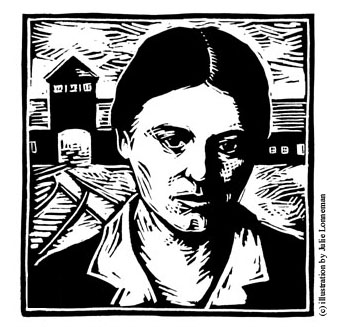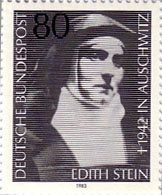
September
2010 - Vol. 42

Blessed
by the Cross:
The
Heroic Life of Edith Stein in Nazi Germany
.
A biographical reflection
by Jeanne Kun
A young woman
in search for the truth
“I keep having to think of Queen Esther who was taken from among her
people precisely that she might represent them before the king,” Sister
Teresa Benedicta wrote to an Ursuline religious sister late in 1938. “I
am a very poor and powerless little Esther, but the King who chose me is
infinitely great and merciful. That is such a great comfort.”
Edith Stein was born into a prominent Jewish family in Breslau, Germany
(present-day Wroclaw, Poland), on Yom Kippur, the Jewish Day of Atonement,
in 1891. As a teenager she abandoned Judaism and became a self-proclaimed
atheist. She attended the university in Breslau and, later, in Göttingen,
where she sought intellectual truth in the study of philosophy and became
a protégé of the famed philosopher Edmund Husserl. She earned
her doctorate of philosophy in 1916, but her search for truth remained
unfulfilled.
The following year Edith was impressed by the calm faith that sustained
a Christian friend at the death of her husband. “It was my first encounter
with the cross and the divine power that it bestows on those who carry
it,” Edith later wrote. “For the first time, I was seeing with my very
eyes the church, born from its Redeemer’s sufferings, triumphant over the
sting of death. That was the moment my unbelief collapsed and Christ shone
forth—in the mystery of the cross.”
A gifted Christian
writer, teacher, and philosopher
A few years later, Edith read St. Teresa of Avila’s Autobiography.
In it she recognized the truth she had been yearning for, and was baptized
on January 1, 1922. Soon after, she became a teacher at the Dominican school
in Speyer. Widely respected in academic circles, she also lectured
throughout Germany, Switzerland, and Austria on women’s role in society,
Catholic education, and philosophy. A gifted writer, she published numerous
books, lectures, reviews, and translations of some of the works of St.
Thomas Aquinas and Cardinal John Henry Newman.
As Hitler rose to power, Edith was quick to perceive what this might
cost her, her family, and her race. In the early 1930s, she wrote to Pope
Pius XI of her concern for the Jewish people, hoping he might divert the
catastrophe she sensed was threatening them. In 1932, she accepted a post
at the Catholic Educational Institute in Münster, but was soon asked
to resign because of growing anti-Semitism in Germany. Edith had long desired
to become a nun and now that her professional effectiveness was severely
limited, she felt that the way was open for her to enter the monastery.
In 1933, when she was forty-two years old, she was received into the Carmelite
community in Cologne.

|
German stamp issued in 1983
in the Women in German history series |
Taking up the cross
of Christ
Edith chose her religious name, Sister Teresa Benedicta of the Cross,
anticipating that she would share in the Lord’s sufferings. “By the cross
I understood the destiny of God’s people which, even at that time, began
to announce itself,” she later explained to a friend. “I thought that those
who recognized it as the cross of Christ had to take it upon themselves
in the name of all.”
As the situation worsened for Jews in Germany, Sister Teresa Benedicta
knew she was not safe in the Cologne monastery and also believed that her
presence there put all the nuns in danger. On the night of December 31,
1938, she crossed into the Netherlands where she was received at the Carmel
monastery in Echt. Her sister Rosa, who had also become a Catholic, later
followed her and served as a lay portress at the monastery. However, the
Nazis occupied the Netherlands in 1940 and Jews, even those who were converts
to Christianity, were no longer safe there either.
A martyr through
the silent working of divine grace
Sister Teresa Benedicta and Rosa were arrested on August 2, 1942, as
part of Hitler’s orders to deport and liquidate all non-Aryan Catholics.
This was in retaliation for a pastoral letter issued by the Dutch bishops
that protested Nazi policies. As the two were taken from the convent, Sr.
Teresa was heard to say to her sister: “Come, Rosa, let us go for our people.”
Their lives ended a week later in the gas chamber at Auschwitz.
Like Queen Esther, Edith Stein identified with her fellow Jews in their
grave danger and interceded for them. When she was formally declared blessed
in 1987 by the Catholic Church, a selection from the Old Testament’s Book
of Esther was read at her beatification ceremony. When she was formally
declared a saint on October 11, 1998, Pope John Paul II noted: “A young
woman in the search of the truth has become a saint and martyr through
the silent working of divine grace: Teresa Benedicta of the Cross, who
from heaven repeats to us today all the words that marked her life: ‘Far
be it from me to glory except in the Cross of our Lord Jesus Christ.’.
. . Now alongside Teresa of Avila and Thérèse of Lisieux,
another Teresa takes her place among the hosts of saints who do honor to
the Carmelite Order.”
[This article is
excerpted from the book, Even
Unto Death: Wisdom from Modern Martyrs, edited by Jeanne Kun, The
Word Among Us Press, © 2002. All rights reserved. Used with permission.
The book can be ordered from WAU
Press.
Jeanne Kun is President
of Bethany
Association and a senior woman leader in the Word
of Life Community, Ann Arbor, Michigan, USA.].
Excerpts
from the writings of Edith Stein
From
Life
in a Jewish Family
The highest
of all the Jewish festivals is the Day of Atonement, the day on which the
High Priest used to enter the Holy of Holies to offer the sacrifice of
atonement for himself and for the people; afterwards, the “scapegoat” upon
whose head, symbolically, the sins of all the people had been laid was
driven out into the desert. All of this ritual has come to an end. But
even at present the day is observed with prayer and fasting, and whoever
preserves but a trace of Judaism goes to the “Temple” on this day. Although
I did not in any way scorn the delicacies served on the other holidays,
I was especially attracted to the ritual of this particular holy day when
one refrained from taking any food or drink for twenty-four hours or more,
and I loved it more than any of the others. . . .
For me the
day had an additional significance: I was born on the Day of Atonement,
and my mother always considered it my real birthday, although celebrations
and gifts were always forthcoming on October 12. (She herself celebrated
her birthday according to the Jewish calendar, on the Feast of Tabernacles;
but she no longer insisted on this custom for her children.) She laid great
stress on my being born on the Day of Atonement, and I believe this contributed
more than anything else to her youngest’s being especially dear to her.
[Excerpt
from Edith Stein’s autobiography, Life in a Jewish Family, written
in 1933, translated by Josephine Koeppel, 1986]
From
a meditation written in the Carmelite monastery at Cologne
The prayer
of the church is the prayer of the ever-living Christ. Its prototype
is Christ's prayer during his human life.
The Gospels
tell us that Christ prayed the way a devout Jew faithful to the law prayed.
Just as he made pilgrimages to Jerusalem at the prescribed times with his
parents as a child, so he later journeyed to the temple there with his
disciples to celebrate the high feasts. Surely he sang with holy enthusiasm
along with his people the exultant hymns in which the pilgrim's joyous
anticipation streamed forth: "I rejoiced when I heard them say: Let us
go to God's house" (Psalm 122:1). From his last supper with his disciples,
we know that Jesus said the old blessings over bread, wine, and the fruits
of the earth, as they are prayed to this day. So he fulfilled one of the
most sacred religious duties: the ceremonial passover seder to commemorate
deliverance from slavery in Egypt. And perhaps this very gathering gives
us the profoundest glimpse into Christ's prayer and the key to understanding
the prayer of the church.
While they
were at supper, he took bread, said the blessing, broke the bread, and
gave it to his disciples, saying, "Take this, all of you, and eat it: this
is my body which will be given up for you."
In the same
way, he took the cup, filled with wine. He gave you thanks, and giving
the cup to his disciples, said, "Take this, all of you, and drink from
it: this is the cup of my blood, the blood of the new and everlasting covenant.
It will be shed for you and for all so that sins may be forgiven."
Blessing and
distributing bread and wine were part of the passover rite. But here both
receive an entirely new meaning. This is where the life of the church begins.
Only at Pentecost will it appear publicly as a Spirit-filled and visible
community. But here at the passover meal the seeds of the vineyard are
planted that make the outpouring of the Spirit possible. In the mouth of
Christ, the old blessings become life-giving words. The fruits of
the earth become his body and blood, filled with his life. Visible creation,
which he entered when he became a human being, is now united with him in
a new, mysterious way. The things that serve to sustain human life are
fundamentally transformed, and the people who partake of them in faith
are transformed too, drawn into the unity of life with Christ and filled
with his divine life. The Word's life-giving power is bound to the sacrifice.
The Word became flesh in order to surrender the life he assumed, to offer
himself and a creation redeemed by his sacrifice in praise to the Creator.
Through the Lord's last supper, the passover meal of the Old Covenant is
converted into the Easter meal of the New Covenant: into the sacrifice
on the cross at Golgotha and those joyous meals between Easter and Ascension
when the disciples recognized the Lord in the breaking of bread, and into
the sacrifice of the Mass with Holy Communion.
[Excerpt
from The Hidden
Life: Vol. IV, The Collected Works of Edith Stein, translated by
Waltraut Stein, © 1992 ICS Publications. Used with permission.]
|
. |
|

